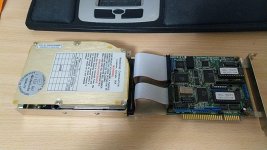Oh, also of note, this drive has something I hadn't seen before, which is the stepper motor has an 'arm' attached to it that moves between what appears to be a sensor of some sort. Sensor is labeled "KT2625" "4063303" "8641" (last one probably date code). Looks like it has wiring for an emitter/detector pair, but can't get a good enough look at it to tell if it's optical.
Seagate ST-412 example, and describing text, at [
here].
BIOS reports 1701 (obviously), ...
Yes, the drive won't be signaling to the controller that it is 'ready'.
I'd expect a different error if it were unable to find track 0, but maybe there's something else it looks for on the media to determine whether a seek worked?
If the 8425 used a servo positioning mechanism, maybe, but according to [
here], it uses a stepper motor.
Considering a stepper motor, other positioning logic could be used in the self-test.
For example, imagine failure of test 6 in the following
fictional example:
Test 5 - Cylinder 0 (track 0) switch
Step 1: If cylinder 0 switch not activated, step out until the cylinder 0 switch activates. If not activated after [drive's cylinder count] steps, trigger 'track 0 switch' error.
Step 2: Step in 1 time (i.e. heads expected to then be over cylinder 1)
Step 3: Verify that the cylinder 0 switch is no longer activated. If not as expected, trigger 'track 0 switch' error.
Step 4: Step out 1 time (i.e. heads expected to then be over cylinder 0)
Step 5: Verify that the cylinder 0 switch is activated. If not as expected, trigger 'track 0 switch' error.
Test 6 - Long stepping test (now that we have very good confidence in the cylinder 0 switch)
Step 1: Step in 20 times (i.e. heads expected to then be over cylinder 20)
Step 2: Step out 5 times (i.e. heads expected to then be over cylinder 15)
Step 3: Step in 100 times (i.e. heads expected to then be over cylinder 115)
Step 4: Step out 115 times (i.e. heads expected to then be over cylinder 0)
Step 5: If cylinder 0 switch not activated, trigger 'seeking' error.


